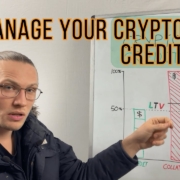Bitcoin ARBITRAGE! Hashrate Contracts VS Hardware Reselling | Hashpower Academy
Dive into the world of Bitcoin arbitrage with this educational breakdown of Hardware Reselling vs. Hashrate Contracts!
Both opportunities revolve around hashrate, the computational power generated by Bitcoin mining hardware.
What You’ll Learn:
Hardware Reselling: Understand how mining hardware is priced ($/TH) based on efficiency, electricity costs, location, and age. Discover how economies of scale enable buying at wholesale discounts (up to 50%) and reselling at retail prices for profit.
Hashrate Contracts: Explore duration-based contracts ($/TH/Day) where miners lock in fixed rates, and buyers earn variable BTC revenue, impacted by Bitcoin price, fees, difficulty, and halving events.
The Big Question:
Could one product unlock arbitrage opportunities in both hardware reselling and hashrate contracts?
Join us to uncover how these markets work and how you can leverage hashrate for maximum potential! Start your Bitcoin education at terahash.finance today! #Bitcoin #CryptoEducation #BitcoinMining #Arbitrage #Hashrate #financialeducation
– – – – – – – – – – – – – – – – – – – – – – – – – – – – – – –
Hashpower Academy Donations (Thank You!):
L1 Bitcoin: bc1qlgkc4pyrz22cykrx49cmuku3zyy2nuequu6r9y
L2 Lightning: academy@walletofsatoshi.com
Hosted Bitcoin Mining accessible to Everyone: (Waitlist) (The Big Question answered!)
https://www.Terahash.Finance/Platform
The Big Picture Basics (Free Bitcoin Course)
https://www.hashpower.academy
Request a Video Topic – Hashpower Academy
https://forms.gle/em32yYXt7TtC3qUY6
Align a meeting if you are looking to explore Mining/Hosting and other Business/Consultation Inquiries:
https://calendly.com/terahash/30min
– – – – – – – – – – – – – – – – – – – – – – – – – – – – – – –
Affiliate Links to support the Hashpower Academy,
By exploring Products, Markets & Services across the Bitcoin Ecosystem:
Wallets – for Self Custody
Trezor: https://affil.trezor.io/SHpa
Ledger: https://shop.ledger.com/?r=0e5e239ec8ba
Blockstream: https://store.blockstream.com/?code=academy
Ngrave: https://www.ngrave.io/?sca_ref=9211144.4mNYVms7D0
Miners – for the Home
HeatBit: https://heatbit.com/?ref=academy
SoloSatoshi: https://www.solosatoshi.com/aff/1405/
IxTech: https://ixtech.xyz/?ref=JAKE
Cloaks: https://www.cryptocloaks.com/aff/Academy/
Platforms to Explore
ViaBTC Pool: https://www.viabtc.info/signup?refer=1553491
TradingView: https://www.tradingview.com/?aff_id=154436
BitRefill: https://www.bitrefill.com/invite/68zjuypv
– – – – – – – – – – – – – – – – – – – – – – – – – – – – – – –
Financial Disclaimer:
This video serves educational and informational purposes only and should not be construed as financial advice or investment recommendation. The views expressed are those of the presenter and do not represent Hashpower Academy’s official stance. Information is provided ‘as is’ without warranties, express or implied, as to its accuracy or completeness. Engaging with Bitcoin involves high risk, including potential financial loss, market volatility, and energy costs, and is suitable only for those who can bear these risks. Always conduct your own research and consult with a qualified financial or technical advisor before making decisions related to Bitcoin.
#Bitcoin #Arbitrage #Mining #hashratecontracts #Blockstream #MiningNote #BTCTC #learn #hashpower #academy
Video Transcript:
Hello there and welcome to the Hash Power Academy, your place to learn anything to do with Bitcoin. Now, the topic of today’s video is comparing hardware reselling to hash rate contracts. Now, some of these different pieces have different names, but they’re also connected together in relation to the fact that Bitcoin mining hardware is what produces hash rate to allow you to sell the hash rate in contracts. So it’s really important to know that a digital to physical divide is the key thing separating these two things. Hardware reselling physically selling the hardware. You’re not plugging it in versus the hardware plugged in producing hash rate and selling it in durationbased contracts to potentially lock in a greater return. The other pieces to know about these two is that they have different moving parts in relation to the hardware and to the hash rate and its profitability. So well let’s just go into hardware reselling first and then we’ll work our way up the chain to hash rate contracts and make the comparison between the two. So the first thing to understand is that Bitcoin mining hardware has three core things essentially. how much power it uses, its efficiency, which converts said power into hash rate. And if you’ve seen previous videos, we’ll have all of those sorts of numbers there available. The key thing is this. It defines a price, a dollar per terash, where you take a machine that’s $5,000, 200 terraash, divide it down, $25 per terash. And the reason why you have this metric is so that you can compare all the other different hardware units that produce different amounts of hash rate. And the second bit to that there are different efficiencies. And the efficiency is that race to consume less power, less electrical bill to produce more hash rate, more mining revenue. And it’s important to continually get more efficient. But here’s the thing. there is older, less efficient machines that when the bull market comes and absolutely rockets the profitability on the mining revenue side of things, the price of old machines go up as well. So that there are people out there that will buy up a large amount of new and old machines in the bare market that they believe they’ve picked the right time and they may not mine with it. They keep it in the box and they sell it in the bull market. So it’s capturing hash rate and hardware essentially when it’s in low low demand and selling it when it’s in high demand and you obviously being the the person that’s supplying it. So it’s this sort of arbitrage of buy in one place at the right time to sell in another at the right time. And this also can be a location thing which I’ve just alluded to which is the hardware that’s in China in a box is of a different value per terash than a machine that’s been shipped over to the US and maybe Trump’s taxed it or not and it’s been actively racked hashing deployed or available to be purchased and hashing within a day or two. That’s great. But there’s a clear difference between that exact same computer in a box in China versus that same computer ready to mine that instant. And so there’s different locationbased values for dollar terash as well. And the age as well, the same model but of different ages. Well, the new one has less history, less potential thermal damage if it’s an air cooled machine. So there’s all these different moving parts related to its conversion efficiency, where it’s located in the world, its age and you know it’s the the quality of the of a particular unit and obviously the Bitcoin price. When the Bitcoin price in dollar terms shoots up in doubles, quadruples, whichever it is, mining machines increase as well. And the hardware resellers and their Excel spreadsheets are defining what the the price that they sell machines for really uh quite quite aligning to the Bitcoin price as the key mover. Now we’ll jump to hash rate contracts which is when you host when you buy a mining machine and hosted you own the machine and it’s a different sort of economics where you’re understanding I spent $5,000 on this one machine I want it to mine more than $5,000 or the 05 bitcoin you want to mine 05 bitcoin in the fouryear say lifespan of mining that’s different to say a 4-year hash rate contract. Hash rate contracts are durationbased contracts where someone else with someone else’s computer is delivering the digital commodity of hash rate into the you know the pointing it to the mining pool or luck uh luck lottery mining of your choosing to then you know capture Bitcoin in in in revenue over time. But you’re not you’re you have no relationship to the actual machine underneath. You have no ownership of it. So it’s a different economic model. And where it changes things is it’s a little bit like trading. And what I mean by that is you’re contending with purchasing hash rate at at a at a particular dollar per terahash member duration contracts per day. This could be a month. It could be 90 days. It could be blockstream mining notes which is four years. It’s that you’re comparing this period of time where you paid for the hash rate. You want the hash rate to obviously recoup the amount of money in return. So what you’re contending with is you’re wanting fees to go up. So you you bought the hash rate when fees were low. So maybe the hash rate contract was priced lower and then fees shoot up. So if you think there’s particular moments in time where there’s going to be lots of fees on the network, there are people that can generate an income by buying hash rate when the fees are low and that that large period of time where there’s lots of fees, they generate they generate a return difficulty. The longer the contract is, you’re contending with the difficulty. We we can’t predict the future, but we can assume that more miners are joining the network as the network is growing. subsidy. We all know every four years it’s getting cut in half. So, you’re contending with this diminishing returns in terms of the quantity of Bitcoin you mine, but also the main driver, the price that if you buy a hash rate contract at a low price and the price jumps up, yes, you’re making a dollar return, but if you use Bitcoin to pay for the hash rate contract, it’s kind of negligent. So, what’s the key comparison between the two? both are buying low, selling high. Or if you’re a minor, you may be selling a hash rate contract because you think the price will drop. You’re not planning to sell the machines that you’ve deployed and don’t plan to move them for several years. So, you want to potentially lock in a higher Bitcoin per terahash per day by selling the hash rate contract to a buyer who thinks the price is going to go up. And so the the seller and the buyer both are meeting terms and one thinks the price is going to go down and up and obviously that’s what financial markets are for. And the the key comparison between the two is the hardware of reselling aspect of things is more so uh capturing inefficiencies of a fragmented decentralized market. Hardware reselling, Bitcoin mining is all around the world, all different countries. And so there’s going to be different prices for the same machines. So a person has good access to logistics or purchases from manufacturer in bulk, get the machines down like half price and then ship them to the US and sell them retail. There’s all these different sort of ways of doing wholesale procurement at scale in volume and sell retail in smaller amounts. And the key comparison between the two is that hardware hardware reselling can potentially generate you an income with scale. There’s a scale of economy aspect to this and that can make a clear difference if you can lock in a margin between buying buying in buying wholesale in China and selling retail that that’s a margin that can be widened with scale of economy. That’s not the same with hash rate contracts. By buying more hash rate, you’re just going to probably naturally drive the price up from wherever you’re buying it from if it’s on an order book instead of or peer-to-peer as well even. But you’ve got this commodity in the middle of hash rate. And it’s it’s kind of an interesting one. And another reason why it’s called the hash power academy is because you’ve got these two markets on both sides. On the physical side of producing the hash rate and the potential to sell that hardware out because it’s in demand to produce hash rate, but also the hash rate contract side of things, which is the the revenue. So you’re sort of looking at the electrical efficiency of the physical good versus the revenue output side on the hash rate contract side of things. And the the path of financializing hash rate is something that I’ve been quite focused on as well. And interestingly enough, people like Adam Back, Blockstream, they have a basic note. I think it still exists, which is basically they’ve they’ve put the hard it’s hardware in its box. It’s not mining uh purchased in bulk to get that cheap price. And the the whole idea of the basic note is to buy the machines low as physical goods, keep them brand new in their box and sell them in that bull market to generate a higher return, but you’re also comparing it to what you could earn by potentially plugging those machines in. So there’s an opportunity cost on the revenue side because they’re not mining and they’re not generating hash rate to produce Bitcoin. They’re just keeping it in the box and selling it when there’s a a a demand for physical goods. Because you got to understand that the digital sides can move and react a lot quicker than physical machines all around the world that have to be moved and there’s costs and they get broken and all other things. And so where it can get interesting is what if there was a combination of the hardware reselling dollar per terahash pricing of things in combination with the machines accessible to purchase plugged in producing hash rate. We also have access to lock in hash rate contracts as well. What if what if there was a way of combining the two in a single product? That’ll be something that you may be able to find in the comments or the description of this video. Thank you for listening. I hope you enjoyed and I’ll see you in the next video. Goodbye.




![Outperforming Bitcoin: Mining Revenue Payback Periods [$/TH] | Hashpower Academy Outperforming Bitcoin: Mining Revenue Payback Periods [$/TH] | Hashpower Academy](https://hashpower.academy/wp-content/uploads/2025/10/Outperforming-Bitcoin-Mining-Revenue-Payback-Periods-TH-Hashpower-Academy-180x180.jpg)









Leave a Reply
Want to join the discussion?Feel free to contribute!